
Inspection Report
Home Buyer
Property Address:
39 Owen Court
Barrie ON
 |
Barrie Home Inspector
Roger Frost
165 Kozlov Street, Unit 27
Barrie, ON L4N 7M8
705-795-8255

Property Address:
39 Owen Court
Barrie ON
 |
Roger Frost
165 Kozlov Street, Unit 27
Barrie, ON L4N 7M8
705-795-8255
| Date: 2004-11-26 | Time: 1:30:03 PM | Report ID: sample 2 |
| Property: 39 Owen Court Barrie ON |
Customer: Home Buyer |
Real Estate Professional: |
Comment Key or Definitions
The following definitions of comment descriptions represent this inspection report. All comments by the inspector should be considered before purchasing this home. Any recommendations by the inspector to repair or replace suggests a second opinion or further inspection by a qualified contractor. All costs associated with further inspection fees and repair or replacement of item, component or unit should be considered before you purchase the property.
Inspected (IN) = I visually observed the item, component or unit and if no other comments were made then it appeared to be functioning as intended allowing for normal wear and tear.
Not Inspected (NI)= I did not inspect this item, component or unit and made no representations of whether or not it was functioning as intended and will state a reason for not inspecting.
Not Present (NP) = This item, component or unit is not in this home or building.
Repair or Replace (RR) = The item, component or unit is not functioning as intended or needs further inspection by a qualified contractor. Items, components or units that can be repaired to satisfactory condition may not need replacement.
Type of Building: Older Home with Additions | Age Of Building: Over 30 years old | Client Is Present: Yes |
Weather: Cloudy | Temperature: Below 60 | Age Of Home: Over 50 Years |
Rain in last 3 days: Yes |
| IN | NI | NP | Items | |
| X | 14.0 | Thermal Imaging Inspection Comments: Free thermal imaging with infrared camera is included with every home inspection. |
||
| IN | NI | NP | Items |
 |
| IN | NI | NP | RR | Items | ||
| X | 15.0 | FOUNDATIONS (Report signs of abnormal or harmful water penetration into the building or signs of abnormal or harmful condensation on building components.) Comments:
|
||||
| X | 15.1 | WALLS (Structural) Comments: |
||||
| X | 15.2 | COLUMNS OR PIERS Comments: |
||||
| X | 15.3 | FLOORS (Structural) Comments: |
||||
| X | 15.4 | CEILINGS (structural) Comments: |
||||
| X | 15.5 | ROOF STRUCTURE AND ATTIC Comments:
|
||||
| IN | NI | NP | RR | Items |
| IN | NI | NP | RR | Items | |||||
| X | 16.0 | WALL CLADDING FLASHING AND TRIM Comments: Stucco over-all appears good except for some areas peeling where obvious. For example on rear of home around balcony porch at rear and at chimney. |
|||||||
| X | 16.1 | DOORS (Exterior) Comments:
|
|||||||
| X | 16.2 | WINDOWS Comments: |
|||||||
| X | 16.3 | GARAGE DOOR OPERATORS (Report whether or not doors will reverse when met with resistance) Comments: The Two door Garage at rear of home appears narrow and may not allow large cars to enter. |
|||||||
| X | 16.4 | DECKS, BALCONIES, STOOPS, STEPS, AREAWAYS, PORCHES AND APPLICABLE RAILINGS Comments:
|
|||||||
| X | 16.5 | VEGETATION, GRADING, DRAINAGE, DRIVEWAYS, PATIOS, WALKWAYS AND RETAINING WALLS (With respect to their effect on the condition of the building) Comments:
|
|||||||
| X | 16.6 | EAVES, SOFFITS AND FASCIAS Comments:
|
|||||||
| IN | NI | NP | RR | Items |
| IN | NI | NP | RR | Items | ||||
| X | 17.0 | ROOF COVERINGS Comments:
|
||||||
| X | 17.1 | FLASHINGS Comments:
|
||||||
| X | 17.2 | SKYLIGHTS, CHIMNEYS AND ROOF PENETRATIONS Comments: |
||||||
| X | 17.3 | ROOFING DRAINAGE SYSTEMS Comments:
|
||||||
| IN | NI | NP | RR | Items |
| IN | NI | NP | RR | Items | ||||
| X | 18.0 | INTERIOR DRAIN, WASTE AND VENT SYSTEMS Comments: |
||||||
| X | 18.1 | INTERIOR WATER SUPPLY AND DISTRIBUTION SYSTEMS AND FIXTURES Comments:
|
||||||
| X | 18.2 | HOT WATER SYSTEMS, CONTROLS, CHIMNEYS, FLUES AND VENTS Comments: |
||||||
| X | 18.3 | MAIN WATER SHUT-OFF DEVICE (Describe location) Comments:
|
||||||
| X | 18.4 | FUEL STORAGE AND DISTRIBUTION SYSTEMS (Interior fuel storage, piping, venting, supports, leaks) Comments:
|
||||||
| X | 18.5 | SUMP PUMP Comments: |
||||||
| IN | NI | NP | RR | Items |
| IN | NI | NP | RR | Items | |||||
| X | 19.0 | SERVICE ENTRANCE CONDUCTORS Comments: |
|||||||
| X | 19.1 | SERVICE AND GROUNDING EQUIPMENT, MAIN OVERCURRENT DEVICE, MAIN AND DISTRIBUTION PANELS Comments: |
|||||||
| X | 19.2 | BRANCH CIRCUIT CONDUCTORS, OVERCURRENT DEVICES AND COMPATIBILITY OF THEIR AMPERAGE AND VOLTAGE Comments: |
|||||||
| X | 19.3 | CONNECTED DEVICES AND FIXTURES (Observed from a representative number operation of ceiling fans, lighting fixtures, switches and receptacles located inside the house, garage, and on the dwelling's exterior walls) Comments:
|
|||||||
| X | 19.4 | POLARITY AND GROUNDING OF RECEPTACLES WITHIN 6 FEET OF INTERIOR PLUMBING FIXTURES, AND ALL RECEPTACLES IN GARAGE, CARPORT, EXTERIOR WALLS OF INSPECTED STRUCTURE Comments: Did not locate any outside outlets? |
|||||||
| X | 19.5 | OPERATION OF GFCI (GROUND FAULT CIRCUIT INTERRUPTERS) Comments: No outlet found in hall bath. Recommend a duplex GFCI outlet be installed by a licensed electrician. No outlet in Hall Bath except for one that is built in light fixture. These outlets are considered unsafe if not grounded and bathroom should have its own duplex GFCI outlet (Ground Fault Circuit Interrupter). |
|||||||
| X | 19.6 | LOCATION OF MAIN AND DISTRIBUTION PANELS Comments: Main panel box is located at room with water heater. However, main disconnect (shut-off) is outside at meter base panel (for your information). |
|||||||
| X | 19.7 | SMOKE DETECTORS Comments: |
|||||||
| IN | NI | NP | RR | Items |
| IN | NI | NP | RR | Items | ||
| X | 20.0 | HEATING EQUIPMENT Comments: |
||||
| X | 20.1 | NORMAL OPERATING CONTROLS Comments: |
||||
| X | 20.2 | AUTOMATIC SAFETY CONTROLS Comments: |
||||
| X | 20.3 | CHIMNEYS, FLUES AND VENTS Comments:
Liner for fireplace or boiler were not inspected by our company. Recommend a qualified chimney sweep inspect for safety. |
||||
| X | 20.4 | SOLID FUEL HEATING DEVICES Comments: |
||||
| X | 20.5 | HEAT DISTRIBUTION SYSTEMS (including fans, pumps, ducts and piping, with supports, insulation, air filters, registers, radiators, fan coil units and convectors) Comments: |
||||
| X | 20.6 | GAS/LP FIRELOGS AND FIREPLACES Comments: |
||||
| X | 20.7 | PRESENCE OF INSTALLED HEAT SOURCE IN EACH ROOM Comments: |
||||
| IN | NI | NP | RR | Items |
| IN | NI | NP | RR | Items | ||
| X | 21.0 | COOLING AND AIR HANDLER EQUIPMENT Comments: Cooling equipment serves the upstairs of home only. The main level has no cooling source (FYI). |
||||
| X | 21.1 | NORMAL OPERATING CONTROLS Comments: |
||||
| X | 21.2 | DISTRIBUTION SYSTEMS (including fans, pumps, ducts and piping, with supports, insulation, air filters, registers, radiators, fan coil units and convectors) Comments:
|
||||
| X | 21.3 | PRESENCE OF INSTALLED COOLING SOURCE IN EACH ROOM Comments: Cooling equipment serves the upstairs of home only. The main level has no cooling source (FYI). |
||||
| IN | NI | NP | RR | Items |
 | 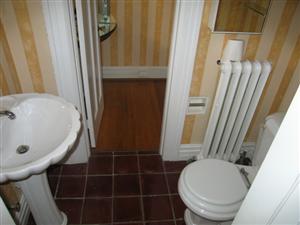 |
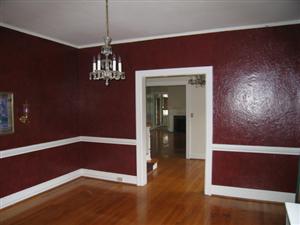 | 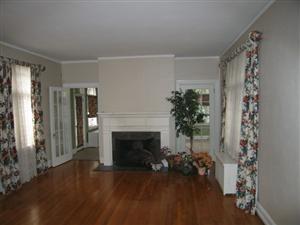 |
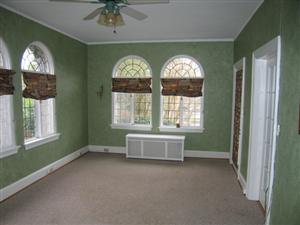 | 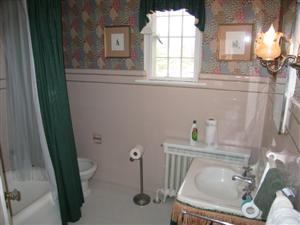 |
 |
| IN | NI | NP | RR | Items | |||
| X | 22.0 | CEILINGS Comments: (1) Plaster on ceiling has several hairline cracks (cosmetic), but should be repaired at various rooms throughout home. While this damage is cosmetic, it needs to be repaired. Recommend repair or replace as needed using a qualified person.
|
|||||
| X | 22.1 | WALLS Comments:
|
|||||
| X | 22.2 | FLOORS Comments: |
|||||
| X | 22.3 | STEPS, STAIRWAYS, BALCONIES AND RAILINGS Comments: |
|||||
| X | 22.4 | COUNTERS AND A REPRESENTATIVE NUMBER OF CABINETS Comments: |
|||||
| X | 22.5 | DOORS (REPRESENTATIVE NUMBER) Comments: |
|||||
| X | 22.6 | WINDOWS (REPRESENTATIVE NUMBER) Comments:
|
|||||
| IN | NI | NP | RR | Items |
| IN | NI | NP | RR | Items | ||
| X | 23.0 | INSULATION AND VAPOR RETARDERS (in unfinished spaces) Comments: Floor system is not insulated. Heat loss can occur more on this home than one that is properly insulated. |
||||
| X | 23.1 | VENTILATION OF ATTIC AND FOUNDATION AREAS Comments: |
||||
| X | 23.2 | VENTING SYSTEMS (Kitchens, baths and laundry) Comments:
|
||||
| X | 23.3 | VENTILATION FANS AND THERMOSTATIC CONTROLS (ATTIC) Comments: |
||||
| IN | NI | NP | RR | Items |
| IN | NI | NP | RR | Items | ||
| X | 24.0 | DISHWASHER Comments: |
||||
| X | 24.1 | RANGES/OVENS/COOKTOPS Comments: |
||||
| X | 24.2 | RANGE HOOD Comments: |
||||
| X | 24.3 | TRASH COMPACTOR Comments: |
||||
| X | 24.4 | FOOD WASTE DISPOSER Comments: |
||||
| X | 24.5 | MICROWAVE COOKING EQUIPMENT Comments:
|
||||
| IN | NI | NP | RR | Items |
 |
INVOICE |
| Barrie Home Inspector
165 Kozlov Street Barrie, ON L4N 6N8 705-795-8255 Inspected By: Roger Frost |
Inspection Date: 2004-11-26
Report ID: sample 2 |
| Customer Info: | Inspection Property: |
| Home Buyer
Customer's Real Estate Professional: |
39 Owen Court Barrie ON |
| ||||||||
Tax $0.00 | ||||||||
| Total Price $399.00 |
Payment Method: Cash
Payment Status: Paid At Time Of Inspection
Note: Please E-Transfer Payment to [email protected]
This inspection was performed in accordance with and under the terms of a Pre-Inspection Agreement. The agreement was signed and agreed upon prior to the preparation of this report and a signed copy of the agreement is available upon request. An unsigned copy of the agreement may be attached to this report for your information or it may also be available on the company web site.
If you were happy with your inspection and would like to add a comment or like on Facebook it would be greatly appreciated. Facebook Link
Thank you,
Roger Frost